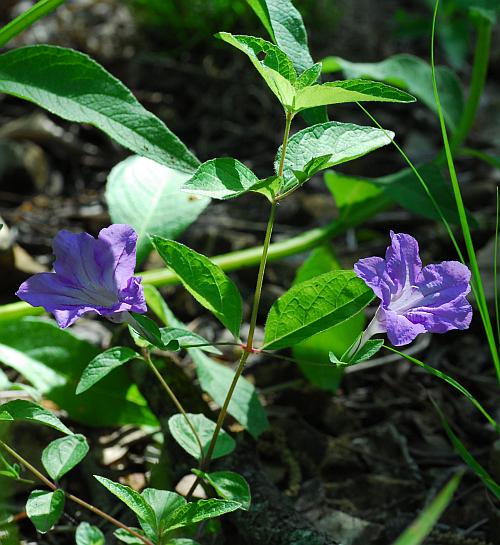Ruellia pedunculata Torr. ex A. Gray
Stalked Wild Petunia

Native
CC = 5
CW = 5
MOC = 35
© SRTurner
Ruellia pedunculata Torr. ex A. GrayStalked Wild Petunia | |
 |
Native CC = 5 CW = 5 MOC = 35 |
© SRTurner |
|
Family - Acanthaceae Habit - Perennial forb. Stems - Ascending to erect, to 70 cm, somewhat angled, usually branched, evenly hairy on all sides with recurved hairs 0.1-0.3 mm long.
Leaves - Opposite, simple, petiolate. Petioles 3-15 mm long. Blades of main stem leaves 2-11 cm long, lanceolate to ovate, mostly tapered to a sharp point at the tip, angled or rounded at the base, hairy on both sides, sometimes sparsely so, minutely hairy along the margins.
Inflorescences - Flower clusters at and near the tip of axillary branches (inflorescence stalks) to 20 cm long, the flowers subtended by hairy, lanceolate to ovate leaflike bracts 7-25 mm long. Peduncles pubescent as the stem. Flowers - Calyx lobes 10-30 mm long, 0.5-1.5 mm wide, linear to bristlelike, hairy. Corollas zygomorphic, 5-lobed, 3-6 cm long, 2-3 cm wide, lavender or bluish. Corolla tube with a whitened, constricted portion at base. Stamens 4, didynamous, adnate at the apex of the constricted portion of the corolla tube. Filaments white, 1.0 cm long, sparsely pubescent at the base, glabrous above. Anthers purplish, 4 mm long. Ovary green, superior, cylindric, 4 mm long, 2-locular. Placentation axile. Style white, 2.6 cm long. Stigma flattened, to 2 mm long.
Fruits - Capsules 13-20 mm long, brown, finely hairy, explosively dehiscent. Flowering - May - September. Habitat - Mesic to dry upland forests, ledges of bluffs, glades, bottomland forests, streambanks, roadsides. Origin - Native to the U.S. Lookalikes - R. strepens. Other info. - This species can be found in the southern third of Missouri. Missouri's populations define the northern extent of the plant's range, which extends in a tight band southward into Louisiana and eastern Texas. The plant can be easily identified by its long, thin calyx lobes and the fact that its flowers are borne on long peduncles. It is a striking plant and would do well in cultivation with minimal care. Photographs taken in Minimum, MO., 5-31-03 (DETenaglia); also at Drury-Mincy Conservation Area, Taney County, MO, 5-2-2012 (SRTurner). |